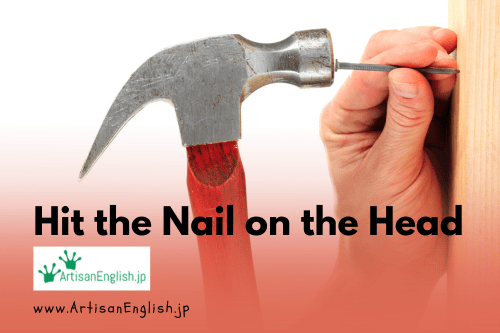
YouTube / iTunes / Spotify / Radio Public / Pocket Casts / Google Podcasts / Breaker / Overcast
Listen to ArtisanEnglish.jp posts & lesson intros here.
Idiom: Hit the nail on the head
If someone mentions a problem they have, and you give them advice that perfectly addresses their concern, you can say you hit the nail on the head.
To hit the nail on the head means to be exactly right about something or to find the most accurate solution to a problem.
This idiom is often used when someone makes an insightful comment or identifies the core of an issue.
In many discussions, it’s important to recognize when someone has hit the nail on the head.
Imagine a classroom setting where a student answers a question correctly.
The teacher might respond by saying, “You’ve hit the nail on the head, that’s exactly what we were looking for!”
Praise with this phrase encourages other students to think critically and strive for the same clarity.
Using this idiom can also help in professional settings.
In meetings, if a colleague presents a solution that addresses the team’s challenges, acknowledging that they hit the nail on the head fosters a positive environment and leads to better teamwork.
It shows appreciation for their insight and might inspire others to contribute more thoughtfully.
What’s more, hitting the nail on the head isn’t just about arriving at a correct answer; it’s also about timing.
When you say something relevant at the right moment, you truly hit the nail on the head.
This can be particularly helpful in negotiations or discussions where clarity and accuracy are essential.
So, hitting the nail on the head is a powerful way to acknowledge precision and insight in conversations.
The next time you recognize a thoughtful comment or a perfect solution, remember to use this phrase to highlight that moment of clarity!
Flesch-Kincaid Readability Test
This post is understandable by someone with at least an 8th-grade education (age 13 – 14).
On the Flesch-Kincaid reading-ease test, this post scores 61.
The easier a passage is to read, the higher the score on a scale of 0 – 100.

